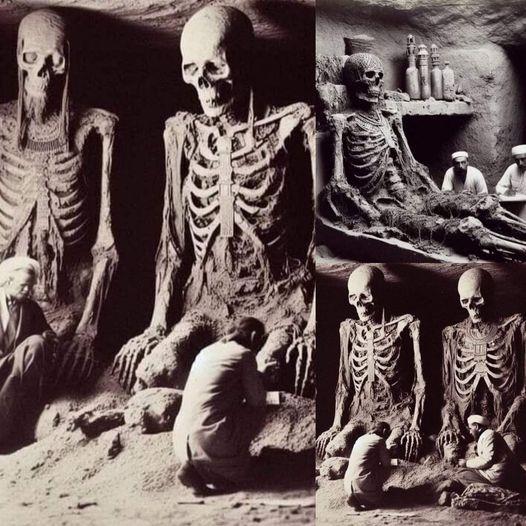Nigel G Wilcox
Powered by S-AM3L1A-NGW
© Copyright Reserved - United Kingdom
Ideal Screen Composition 1024 x 768
Giants
Introduction To The Forbidden Archaeology
Giants
Giant Humanoid Skeletons
P4
P3
P2
P1
P5
P6
P7
P8
P9
Mummies of Giant Pharaohs. 1920s. Howard Carter found many of these artifacts in a tomb excavation in Egypt
Giant Skeletons:
The 1920s were a golden era for Egyptology, marked by some of the most astonishing discoveries in the field. Among these were the mummies of giant pharaohs, unearthed during a series of significant excavations led by the legendary archaeologist Howard Carter. Known primarily for his discovery of Tutankhamun’s tomb in 1922, Carter’s work extended beyond this famous find, revealing a wealth of information about ancient Egyptian royalty. The mummies of these colossal pharaohs offered a new perspective on the grandeur and physicality of Egypt’s rulers, challenging previous understandings of their stature and influence. This blog post will delve into the historical context of these discoveries, the significance of the mummies, and the impact they have had on our understanding of ancient Egypt. We invite readers to explore the images that capture these remarkable artifacts and provide a visual journey through Carter’s groundbreaking excavations.
Howard Carter’s career as an archaeologist is often synonymous with the discovery of Tutankhamun’s tomb, but his work in the 1920s extended well beyond this iconic find. During this period, Carter and his team excavated various sites across Egypt, contributing significantly to the understanding of ancient Egyptian history.
One of the most intriguing aspects of Carter’s work involved the discovery of the mummies of giant pharaohs. These mummies, unearthed from a series of tombs in the Valley of the Kings and other significant sites, revealed an unexpected detail: the pharaohs were depicted as much larger than average humans. This discovery led to a re-evaluation of the physical representation and grandeur of Egypt’s royal figures.
The process of excavating these mummies was meticulous and challenging, involving careful unwrapping and analysis to preserve the delicate remains. Carter’s attention to detail and commitment to preserving the integrity of these finds were crucial in uncovering the true extent of their significance.
To get a sense of the scale and setting of Carter’s excavations, we encourage readers to view the accompanying images, which showcase the excavation sites, the condition of the tombs, and the mummies themselves.
The Significance of the Giant Pharaohs: Insights into Ancient Egyptian Royalty
The mummies of the giant pharaohs provided valuable insights into the physicality and ceremonial practices of ancient Egyptian royalty. These pharaohs were often depicted as larger-than-life figures, a reflection of their divine status and the power they wielded over their subjects. The discovery of their mummies confirmed that this depiction was not merely artistic exaggeration but had a basis in reality.
The physical size of these mummies, coupled with their elaborate tombs and accompanying artifacts, highlighted the importance of these rulers in ancient Egyptian society. The scale of the tombs and the grandeur of the burial goods found with the mummies underscored the high regard in which these pharaohs were held.
Moreover, the study of these mummies provided new information about the health, diet, and lifestyle of Egypt’s royalty. Analysis of the mummies’ remains offered clues about the medical conditions they may have suffered from, their dietary habits, and even their methods of embalming. This information enriched our understanding of how ancient Egyptians viewed and cared for their rulers, both in life and in death.
For a closer look at the mummies and the artifacts found with them, we invite readers to explore the images that depict the detailed examination of these royal remains and the opulent burial goods that accompanied them.
Impact on Modern Egyptology: Legacy and Ongoing Research
The discovery of the mummies of giant pharaohs had a profound impact on the field of Egyptology and the study of ancient Egypt. Carter’s findings challenged previous assumptions about the physical appearance and ceremonial practices of Egyptian royalty, leading to a more nuanced understanding of their history and culture.
The ongoing research into these mummies has continued to yield new discoveries, as modern technologies such as CT scanning and DNA analysis provide deeper insights into the lives and health of these ancient rulers. These advancements have allowed researchers to examine the mummies non-invasively, offering fresh perspectives on their physical attributes and the conditions under which they were mummified.
The legacy of Carter’s work also extends to the preservation and exhibition of these mummies and their associated artifacts. Many of the items discovered in the 1920s are now housed in prestigious museums around the world, where they continue to educate and inspire new generations of scholars and enthusiasts.
To appreciate the ongoing research and the legacy of Carter’s discoveries, we encourage readers to view the images of the mummies and artifacts as they are displayed in modern exhibitions. These visuals offer a glimpse into the continued exploration of ancient Egypt’s royal past and the advancements in our understanding of its history.
Conclusion: Reflecting on the Giants of Ancient Egypt
The mummies of giant pharaohs discovered by Howard Carter in the 1920s remain one of the most captivating aspects of ancient Egyptian archaeology. These findings not only revealed the physical grandeur of Egypt’s rulers but also provided invaluable insights into their lives and the society that revered them.
Carter’s work in uncovering these mummies has had a lasting impact on our understanding of ancient Egypt, challenging historical assumptions and paving the way for ongoing research. The meticulous excavation and analysis of these mummies continue to enrich our knowledge of ancient Egyptian royalty and their cultural significance.
For those interested in exploring the wonders of ancient discoveries, Shazdeh Garden, the recent finds under the Sahara Desert, and other archaeological treasures offer a broader context for understanding the richness of human history. Each new discovery adds depth to our appreciation of past civilizations and their enduring legacies.
We invite readers to explore the images of the giant pharaohs’ mummies and their associated artifacts, which provide a visual connection to the grandeur of ancient Egypt. These photographs not only highlight the remarkable achievements of Howard Carter and his team but also celebrate the timeless allure of Egypt’s royal past.
Click for latest software
P10
Forbidden Archaeology Menu
The Paragon Alternative History And Science
Main
Publication
Menu
Jul 30, 2024
The Historical Context: Carter’s Excavations in the 1920s





